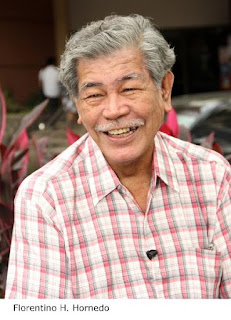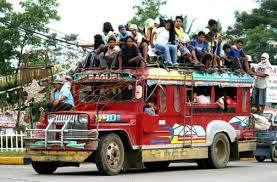In memory of the late Dr. Florentino H. Hornedo
"The Visitor and the Native in the Jeepney and the Tricycle"
By Dr. Florentino H. Hornedo
Professor UST Graduate School
UNESCO Commissioner
The
Anthropologist Frank Lynch S.J., after years of careful observation of natural
and cultural patterns in Philippine history, concluded: “Today’s native is
yesterday’s visitor.” In today’s continuing definition of what is called
“Filipino Identity”, it may be time to see what Fr. Lynch saw and what many
have since began to consider – the nativization of the visitor. I myself wish
to illustrate this process by the ubiquitous jeepney and the tricycle.
The Willys jeep acme came as a visitor some fifty years
ago. It was a durable short vehicle that could, with some effort, accommodate
some half dozen persons. Then the Filipino got hold of this raw material and
created something very different. The four wheels are still there, but it is no
longer as short as the original. It is still a passenger vehicle, but it can
now load – if not in theory, at the very least in fact – some three dozen
people (PHOTO). It has lost its canvas up and now sports a roof nearly inspired by the
turtle’s shell. It can have windows that look more like domestic windows
complete with curtains and colored jalousies made of glass or plastic. Its
dashboard now carries a portable altar that makes of the vehicle a mobile
chapel of sorts. And its windshield has became a veritable billboard for humorous
stickers as well as political and religious statements.
Whatever engineering went into the design of its seat has
declared itself independent of the matter of convenience, comfort and security
for the users. The number of passengers is determined not by Filipino
philosophy not the laws of physics but by the driver’s calculation of how many
can fit within unreasonable limits, and assure him the most fare for his trip.
On the hood, the memory of rural cockfight is memorialized by metallic roosters
caught in their gloriously futile attempt to win over an absent opponent.
Similarly, miniature racehorses might bounce to and fro
on their spring base, while nearly a dozen mirrors face a single direction for
no one’s particular benefits. In the days when the law did not prohibit radios
and the jeepney was a mobile jukebox, it had antennae tall enough to serve as
transmitting tower, ornamented with bunting and frill in rainbow colors. When
the law attempted to get rid of the radio, the antenna remained in useless memory
of lost function.
Generation
of public transportation administration have attempted to assassinate this
durable creation and technology has modified its regal design to the vulgarity
of the Fierra and the old Tamaraw – both to no avail. In many
instances, the elegantly carved glass mirrors with lines inspired by art deco
and baroque have completely bowed out in favor of nondescript mirrors which
serve little else than give the illusion of spaciousness.
The jeepney is also not above masquerading as a cargo
truck, loading cavans of rice and crates of fruits to the unpredictable
consternation or delight of commuters who, accordingly sit themselves on the
jeepney’s hood or when possible, its roof.
 A more recent visitor is the Honda motorcycle from Japan.
It came on two wheels and was a good for two passengers. The Filipino took it
in and regurgitated it as a tricycle (PHOTO) which in its more desperate and felicitous
moments, can carry eight people. Here the laws of mechanics and physics are
suspended by a cultural sort of hocus pocus that works. The Filipino genius at
work has made a clear distinction between comfort and transport. While in other
matters such as food, the Filipino loves mix-ups divinely, in this kind of
vehicular dispensation, he becomes strictly enamored of a clear distinction: if
you want comfort keep out and buy yourself a car. But if you want transport, be
ready to be retreated as an ordinary cargo! The tricycle has become a
legitimate purveyor of oral tradition and criticism, as well as a veritable
vent for the little and many frustrations of daily life voiced through graffiti
and stickers which say no in uncertain terms what the driver damn wishes to
say, if to no one else, then at leave to himself.
A more recent visitor is the Honda motorcycle from Japan.
It came on two wheels and was a good for two passengers. The Filipino took it
in and regurgitated it as a tricycle (PHOTO) which in its more desperate and felicitous
moments, can carry eight people. Here the laws of mechanics and physics are
suspended by a cultural sort of hocus pocus that works. The Filipino genius at
work has made a clear distinction between comfort and transport. While in other
matters such as food, the Filipino loves mix-ups divinely, in this kind of
vehicular dispensation, he becomes strictly enamored of a clear distinction: if
you want comfort keep out and buy yourself a car. But if you want transport, be
ready to be retreated as an ordinary cargo! The tricycle has become a
legitimate purveyor of oral tradition and criticism, as well as a veritable
vent for the little and many frustrations of daily life voiced through graffiti
and stickers which say no in uncertain terms what the driver damn wishes to
say, if to no one else, then at leave to himself.
The logic if this method of defining cultural identity is
the evidence arithmetic of the subtrahend and the remainder. Take away from the
present jeepney and tricycle those things that were in their original form as
visitors – the Willys and the Honda – and what is left is what we can call
Filipino, our contribution, our identifier.
After the subtraction of course, these creation will not
ruin since the engines too are visitors. But there is such thing for the
Filipino as appropriation by extended possession – the metaphysical ground for
the philosophy of squattership. And maybe, in this sense, the imported engine
becomes Filipino and naturalized by extended possession and/or association.
It is clear from the foregoing that the logic of the
definition of Filipinicity transcends the arithmetic of the subtrahend and the
remainder. There is a minuend that refuses to be reduced by simple subtraction
of the visitor from it in order to arrive at the identity of the remainder. The
minuend has arrogated unto itself a kind of wholeness and identity which
combine the foreign raw material with local contribution in a manner that is
less mechanical – the way an appendage becomes conjoined with another to
produce nothing more than appendages – and more organic and assimilative – the
way food becomes a constitutive part of the eater. The Filipino addition to the
jeep and the tricycle is not an appendage but an identity, a habitation and a
name. The metamorphoses s a growth, an adaption to environment, a response to a
need which the original creator of the raw material did not know nor
appreciate. What has happened is what happens to muscovado when it is transmuted into a rainbow-colored candy stick, or what happens to the tubes of
paint when they are transformed into works of art. What happens in the
transition is a creative event and the result is a persona.
The Filipino has, for ages, been on the receiving end of
things foreign, in terms of both goods and needs. Among the goods have been the
jeep and the motorcycle and among the needs have been mobility and convenience.
When one adds to these the need to maximize within very limited means in order
to meet the demands of a large and growing population, the result is the
synthesis of a minimal, borrowed, raw material and a craftsmanship desirous of
maximal utility. That explains the enlargement of the jeepney and the addition
of one more wheel and a passenger compartment to the tricycle. It is a
technological translation of the Filipino proverbs. “Mamaluktot habang angkumot ay maigsi.” (Crouch if your blanket is
short.)
But the Filipino also brings in his cultural and
individual personality into the new vehicle. In his traditional transport
-- the kalesa (PHOTO), the carabao or ox-drawn cart, or the back of the carabao,
he is ferrying either townmates or member of his own family as they return from
the farms. In this traditional transport system, personalism is a factor which
makes trips both social and satisfying. One can talk at leisure about familiar
matters and mutual concerns. The driver is not an outsider not a stranger. He
may even be the head of his family, and to play a role in the cart as the
driver is really to play all over his role in his house as father and family
head. The cart is a kind of home, and the kalesa
is a kind of social venue, and in both cases the marks of home and native
social community make the technological object familiar and psychologically
satisfying.
But the jeepney and the tricycle answer a different kind
of need. More people must be transported and at the shortest possible time.
There is no time for social conversation nor is it possible at all due to the
impersonality of the big crowd which rides in order to rush to work or to the
market and not to socialize. It is now understandable why the driver must
create for himself within the vehicle the permanent substitutes for a vanished
social and familial function.
Bullock drawn bridal cart
The traditional features of his society and the
personalized characteristics of home must accompany him come hell or high
water. The wife’s embroidery and tasselled drapery must be there. Icons of
favourite religious patrons are enthroned on the dashboard as they are in the
family altar. His drinking partners and their punning jokes often off color,
are there, too. “ipitin pa lamang nang
magkahusto!” “Jeepney driver, short
time loser.” God knows Hudas not pay.” Or,
to tell the world that this jeepney was bought with hard-earned money
from Saudi Arabia, he hangs a sign below the back entrance.”Katas ng Saudi.” Or if he wishes to
laugh at the foiblesof a poor world, he less his ticket do the work: “inay, sino po ang tatay ko! Ewan, marami
sila.”
Graffiti of this sort are also attempts to speak to the passengers
and lesson the growing impersonalism in the environment. They are psychological
coping mechanisms produced by a social spirit forced into an increasingly
depersonalized world. Filipinizing is the process of exorcising the alienness
of the borrowed technology by bringing into it the familiar and social marks
and features of Filipinicity, thus giving the new creation a familiarity a
habitation and a name. it involves the enviness right of the free to name the
world they create.
The creative adoption of the “visitor” in order to make
it a naïve is an assertion of creative freedom. It is an affirmation of both
interdependence and independence of spirit. This I hold to be as true to the
transformed vehicles as to so much of other features of Filipino art, sciences
ad technologies, which ones came to the country as visitors. And the miracle is
that transformation is probability one form of native hospitality, which is the
one thing we are never short of nor without. ~
------------
Posted by Dr Abe V Rotor in his honor and in recognition for being an outstanding Filipino educator and social scientist.





No comments:
Post a Comment